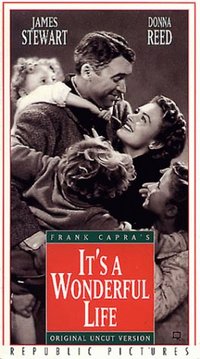It's a Wonderful Life
It's a Wonderful Life is a 1946 Frank Capra film, produced by his own Liberty Films, and released originally by RKO Radio Pictures. more...
Story
The movie begins with an apprentice angel named Clarence being given his final assignment before becoming a true angel: Help George Bailey (played by James Stewart), a man who sacrificed his dreams to help his town. Faced with a financial and legal crisis, he is contemplating suicide.
After being fully briefed on George's life, Clarence descends and gives George the opportunity to view how the world would be if George were never born. While going through the world in this state, George learns that his beloved hometown of Bedford Falls came under the control of his longtime nemesis, Mr. Potter, and was turned into a center of vice. He also discovers that the people he loves - his wife, brother, and friends - are all dead or suffering in "Pottersville."
After experiencing this alternate reality, George decides that life is truly worth living and returns. To his joy, he finds that the entire town had pitched in to save his bank from going under and himself being arrested, culminating with a rich industrialist friend authorizing a massive advance and his own younger brother leaving his own presidential decoration ceremony early to help his sibling. Because of his work, Clarence was able to "get his wings" and become a true angel. When he gets his wings, a bell on the Bailey's Christmas tree rings.
Production and distribution
Filming started on April 15, 1946 and ended on July 27, 1946. The film premiered on December 20, 1946.
The film was panned by some critics and was not a box-office hit upon initial release (placing 26th for the year, one place ahead of another Christmas movie, Miracle on 34th Street), although it did receive five Academy Award nominations, including Best Picture, Best Director, and Best Actor. It was only after its copyright was not renewed in 1974 that people began to take a second look at this film. It entered the public domain and many television stations began airing the film free of charge and royalties. In the 1980s (the beginning of the home video era) the film finally received the acclaim it didn't receive in 1946, thus becoming a perennial holiday favorite. For several years, it became expected that the movie would be shown multiple times on at least one station and on multiple stations in the same day, often at the same or overlapping times. It was a common practice for American viewers to jump in and out of viewing the movie at random points, confident they could easily pick it up again at a later time. The film's warm and familiar ambience gave even isolated scenes the feel of holiday "comfort food" for the eyes and ears. The film's public domain success is often cited as a reason to limit copyright terms, which have been frequently extended by Congress in the United States.
Two colorized versions have since been produced; they are widely considered to be of inferior quality to the black and white original. They are often held up by opponents of colorization as an example of the flaws associated with the process. For many years, some stations paid substantial royalties to show a colorized version as it was viewed as more profitable to show the colorized versions than the black and white original.
In 1993, Republic Pictures (whose predecessor, National Telefilm Associates, originally bought key rights to the film, including the original television syndication rights, the original nitrate film elements, the music score, and the story on which the film is based, The Greatest Gift) relied on the 1990 U.S. Supreme Court ruling in Stewart v. Abend (which involved the movie Rear Window) to enforce its claim of copyright, because, while the film's copyright had not been renewed, it was a derivative work of various works that were still copyrighted. As a result, the film is no longer shown as much on television (NBC is currently licensed to show the film on U.S. network television), the colorized versions have been withdrawn, and Republic now has exclusive video rights to the film (under license with Artisan Entertainment).
Read more at Wikipedia.org




